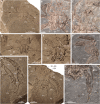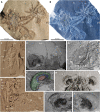Exceptional preservation of mid-Cretaceous marine arthropods and the evolution of novel forms via heterochrony
- PMID: 31032408
- PMCID: PMC6482010
- DOI: 10.1126/sciadv.aav3875
Exceptional preservation of mid-Cretaceous marine arthropods and the evolution of novel forms via heterochrony
Abstract
Evolutionary origins of novel forms are often obscure because early and transitional fossils tend to be rare, poorly preserved, or lack proper phylogenetic contexts. We describe a new, exceptionally preserved enigmatic crab from the mid-Cretaceous of Colombia and the United States, whose completeness illuminates the early disparity of the group and the origins of novel forms. Its large and unprotected compound eyes, small fusiform body, and leg-like mouthparts suggest larval trait retention into adulthood via heterochronic development (pedomorphosis), while its large oar-like legs represent the earliest known adaptations in crabs for active swimming. Our phylogenetic analyses, including representatives of all major lineages of fossil and extant crabs, challenge conventional views of their evolution by revealing multiple convergent losses of a typical "crab-like" body plan since the Early Cretaceous. These parallel morphological transformations may be associated with repeated invasions of novel environments, including the pelagic/necto-benthic zone in this pedomorphic chimera crab.
Figures






Similar articles
-
Exceptional preservation of comma shrimp from a mid-Cretaceous Lagerstätte of Colombia, and the origins of crown Cumacea.Proc Biol Sci. 2019 Dec 4;286(1916):20191863. doi: 10.1098/rspb.2019.1863. Epub 2019 Nov 27. Proc Biol Sci. 2019. PMID: 31771467 Free PMC article.
-
The Phylogeny and Evolutionary History of Arthropods.Curr Biol. 2019 Jun 17;29(12):R592-R602. doi: 10.1016/j.cub.2019.04.057. Curr Biol. 2019. PMID: 31211983 Review.
-
Convergent Adaptation of True Crabs (Decapoda: Brachyura) to a Gradient of Terrestrial Environments.Syst Biol. 2024 Jul 27;73(2):247-262. doi: 10.1093/sysbio/syad066. Syst Biol. 2024. PMID: 37941464 Free PMC article.
-
An early Cambrian euarthropod with radiodont-like raptorial appendages.Nature. 2020 Dec;588(7836):101-105. doi: 10.1038/s41586-020-2883-7. Epub 2020 Nov 4. Nature. 2020. PMID: 33149303
-
Fossils and the Evolution of the Arthropod Brain.Curr Biol. 2016 Oct 24;26(20):R989-R1000. doi: 10.1016/j.cub.2016.09.012. Curr Biol. 2016. PMID: 27780074 Review.
Cited by
-
Palaeoecology of Voulteryon parvulus (Eucrustacea, Polychelida) from the Middle Jurassic of La Voulte-sur-Rhône Fossil-Lagerstätte (France).Sci Rep. 2019 Mar 29;9(1):5332. doi: 10.1038/s41598-019-41834-6. Sci Rep. 2019. PMID: 30926859 Free PMC article.
-
A phylogenomic framework, evolutionary timeline and genomic resources for comparative studies of decapod crustaceans.Proc Biol Sci. 2019 Apr 24;286(1901):20190079. doi: 10.1098/rspb.2019.0079. Proc Biol Sci. 2019. PMID: 31014217 Free PMC article.
-
New Records of Sand Crabs (Crustacea: Decapoda: Albuneidae and Blepharipodidae) from the Western Pacific with Description of Two New Species of Paralbunea Serène, 1977.Zool Stud. 2020 May 12;59:e15. doi: 10.6620/ZS.2020.59-15. eCollection 2020. Zool Stud. 2020. PMID: 33262839 Free PMC article.
-
Impact of ontogeny and spines on the hydrodynamic performance of the Cambrian arthropod Isoxys.R Soc Open Sci. 2024 Dec 11;11(12):240894. doi: 10.1098/rsos.240894. eCollection 2024 Dec. R Soc Open Sci. 2024. PMID: 39677541 Free PMC article.
-
Exceptional preservation of comma shrimp from a mid-Cretaceous Lagerstätte of Colombia, and the origins of crown Cumacea.Proc Biol Sci. 2019 Dec 4;286(1916):20191863. doi: 10.1098/rspb.2019.1863. Epub 2019 Nov 27. Proc Biol Sci. 2019. PMID: 31771467 Free PMC article.
References
-
- Ng P. K. L., Guinot D., Davie P. J. F., Systema brachyurorum: Part I. An annotated checklist of extant brachyuran crabs of the world. Raffles Bull. Zool. 17, 1–286 (2008).
-
- Tsang L. M., Schubart C. D., Ahyong S. T., Lai J. C. Y., Au E. Y. C., Chan T.-Y., Ng P. K. L., Chu K. H., Evolutionary history of true crabs (Crustacea: Decapoda: Brachyura) and the origin of freshwater crabs. Mol. Biol. Evol. 31, 1173–1187 (2014). - PubMed
-
- S. T. Ahyong, Z. Q. Zhang, in Animal Biodiversity: An Outline of Higher-Level Classification and Survey of Taxonomic Richness, Z. Q. Zhang, Ed. (Zootaxa, 2011), pp. 165–191. - PubMed
-
- C. E. Schweitzer, R. M. Feldmann, A. Garassino, H. Karasawa, G. Schweigert, Systematic List of Fossil Decapod Crustacean Species (Crustaceana Monographs, Brill, 2010), vol. 10, pp. 222.
-
- Luque J., Schwitzer C. E., Santana W., Portell R. W., Vega F. J., Klompmaker A. A., Checklist of fossil decapod crustaceans from tropical America, part I: Anomura and Brachyura. Nauplius 25, e2017025 (2017).
Publication types
MeSH terms
LinkOut - more resources
Full Text Sources

